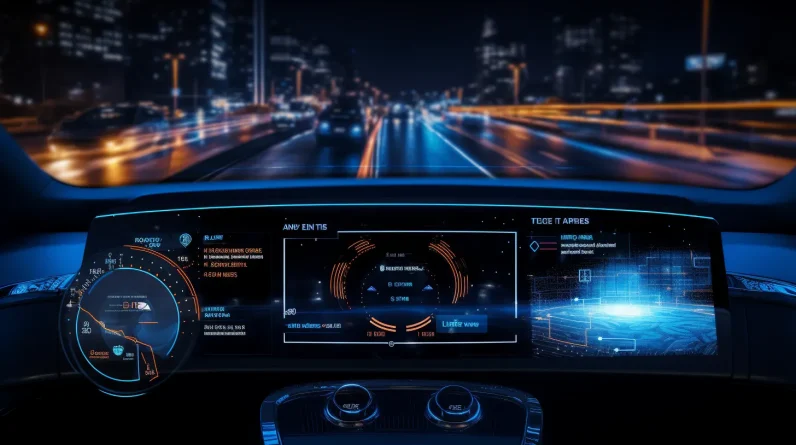
Did you know that every year, over 1.35 million people lose their lives in road accidents? This alarming statistic highlights the pressing need for safer driving practices.
With advancements in technology, automation is playing an increasingly vital role in ensuring road safety. In this article, we will explore the latest smart gadgets that are revolutionizing the way we drive, from lane departure warning systems to autonomous emergency braking.
Join us as we delve into the world of automation on the road, empowering drivers to experience freedom without compromising safety.
Key Takeaways
– Lane departure warning systems and adaptive cruise control are smart gadgets that contribute to safer driving by reducing accidents caused by unintentional lane changes and maintaining a safe distance from the vehicle ahead.
– Smart mirrors enhance visibility by eliminating blind spots and providing a wider field of vision, making them an essential tool for safer driving.
– Autonomous emergency braking systems automatically apply brakes to prevent collisions, saving lives and reducing accident severity. They also have the potential to significantly reduce the frequency and severity of accidents.
– The integration of these smart gadgets in vehicles incentivizes the adoption of safety technology and benefits drivers financially through insurance discounts.
The Power of Lane Departure Warning Systems
Lane departure warning systems, equipped with advanced sensors and algorithms, have proven to be effective in reducing the number of accidents caused by unintentional lane changes. These systems utilize artificial intelligence in vehicle navigation to detect when a driver is drifting out of their lane without signaling. By providing timely alerts, lane departure warning systems help drivers stay aware of their position on the road and take corrective action, thus preventing potential collisions.
One of the key benefits of using lane departure warning systems is their ability to enhance safety on the roads. According to studies, these systems have significantly reduced the occurrence of accidents related to lane departures. By alerting drivers to their unintended lane changes, these systems can help prevent collisions with other vehicles, road barriers, or even pedestrians. This not only protects the driver and their passengers but also promotes overall road safety.
Another advantage of lane departure warning systems is their potential to reduce driver fatigue. Long journeys on monotonous highways can lead to driver drowsiness, increasing the risk of unintentional lane changes. However, with the assistance of lane departure warning systems, drivers are reminded to stay within their lane, helping them stay focused and alert throughout their journey.
Enhancing Safety With Adaptive Cruise Control
An important aspect of enhancing safety on the roads is through the implementation of adaptive cruise control, which allows vehicles to automatically adjust their speed and maintain a safe distance from the vehicle ahead.
Adaptive cruise control (ACC) is a smart technology that utilizes sensors and radar to detect the distance and speed of the vehicle in front. It then adjusts the car’s speed accordingly to maintain a safe distance. This technology has numerous benefits in improving driving safety.
One of the key benefits of adaptive cruise control is its ability to prevent rear-end collisions. By automatically adjusting the vehicle’s speed, ACC helps to avoid sudden braking or accelerating, reducing the risk of accidents caused by human error.
ACC can also help reduce driver fatigue, especially on long journeys. It takes the burden off the driver by maintaining a safe distance and adjusting speed accordingly, allowing them to focus more on the road and less on constantly monitoring and adjusting their speed.
Adaptive cruise control can also contribute to smoother traffic flow. By maintaining a consistent speed and safe distance, ACC helps to reduce unnecessary braking and accelerating, leading to a more efficient and harmonious flow of traffic.
Adaptive cruise control is a valuable technology that offers significant benefits in improving driving safety. It not only helps in preventing accidents but also reduces driver fatigue and contributes to smoother traffic flow. As technology continues to advance, it is crucial to embrace and implement these smart gadgets on our roads to ensure a safer and more efficient driving experience for all.
Smart Mirrors: Keeping an Eye on Blind Spots
Smart mirrors are becoming an essential feature in modern vehicles, as they use advanced technology to eliminate blind spots and enhance driver visibility. These innovative mirrors employ cameras and displays to provide drivers with a clear view of their surroundings, reducing distractions and improving overall safety on the road.
Traditional side and rear-view mirrors have limitations when it comes to providing a comprehensive view of the vehicle’s surroundings. Blind spots can be a major hazard, leading to accidents and collisions. However, smart mirrors address this issue by offering a wider field of vision and eliminating blind spots. By capturing real-time footage from multiple angles and displaying it on a digital screen, smart mirrors allow drivers to have a complete view of their surroundings.
Smart mirrors can also enhance visibility during adverse weather conditions. With features like automatic dimming and glare reduction, these mirrors ensure that drivers maintain a clear view of the road at all times. Additionally, some smart mirrors offer integrated features such as gesture recognition and voice commands, making it easier for drivers to operate them without taking their eyes off the road.
The Future of Car Automation: Autonomous Emergency Braking
As technology continues to evolve, car manufacturers are increasingly integrating autonomous emergency braking systems into their vehicles, ensuring safer driving experiences for all. Autonomous emergency braking (AEB) is a technology that uses sensors to detect imminent collisions and automatically applies the brakes to prevent or mitigate the impact. This innovative system has the potential to save lives and reduce the severity of accidents.
One of the key ethical considerations surrounding autonomous emergency braking is the issue of decision-making. In emergency situations, the AEB system must determine the most appropriate course of action to minimize harm. This raises questions about how these systems should prioritize the safety of occupants versus pedestrians or other vehicles. Striking a balance between these competing priorities is a complex challenge that requires careful consideration.
The impact of autonomous emergency braking on insurance rates is a topic of interest. Insurance companies are recognizing the potential of AEB systems to significantly reduce the frequency and severity of accidents. As a result, some insurers are offering discounts to policyholders who have vehicles equipped with AEB. This not only incentivizes the adoption of this technology but also creates a financial benefit for drivers who prioritize safety.
Frequently Asked Questions (FAQs)
How Much Does It Cost to Install a Lane Departure Warning System in a Vehicle?
The cost of installing a lane departure warning system in a vehicle varies depending on the make and model, as well as the complexity of the system. However, the benefits of such a system include increased safety and reduced risk of accidents.
Can Adaptive Cruise Control Be Used in All Types of Weather Conditions?
Adaptive cruise control performance and effectiveness can vary in different weather conditions. While it is generally designed to function in various scenarios, factors such as heavy rain, snow, or fog may impact its capabilities and require drivers to exercise caution.
Are There Any Additional Features or Functions That Smart Mirrors Offer, Apart From Monitoring Blind Spots?
Smart mirrors offer a range of additional features and functions beyond monitoring blind spots. These include lane departure warning systems, which can alert drivers if they unintentionally drift out of their lane. However, the cost of installing such systems should be considered.
How Long Does It Typically Take for Autonomous Emergency Braking to Engage When a Potential Collision Is Detected?
The typical engagement time for autonomous emergency braking (AEB) varies depending on multiple factors such as vehicle speed, sensor accuracy, and reaction time. These factors can affect the system’s ability to detect and respond to potential collisions in a timely manner.
What Are the Potential Drawbacks or Limitations of Using These Smart Gadgets for Safer Driving?
While smart gadgets for safer driving offer numerous benefits, there are potential drawbacks and limitations to consider. These include the reliance on technology, potential malfunctions, privacy concerns, and the risk of over-reliance leading to complacency and decreased driver vigilance.
Conclusion
In conclusion, the integration of smart gadgets in vehicles has proven to enhance safety on the road.
Lane Departure Warning Systems help drivers stay within their lanes, while Adaptive Cruise Control maintains a safe distance from other vehicles.
Smart mirrors provide improved visibility of blind spots, reducing the risk of accidents.
Looking ahead, the future of car automation lies in Autonomous Emergency Braking, which has the potential to prevent collisions.
These advancements in technology offer a euphemistic approach to ensuring safer driving experiences for all.







